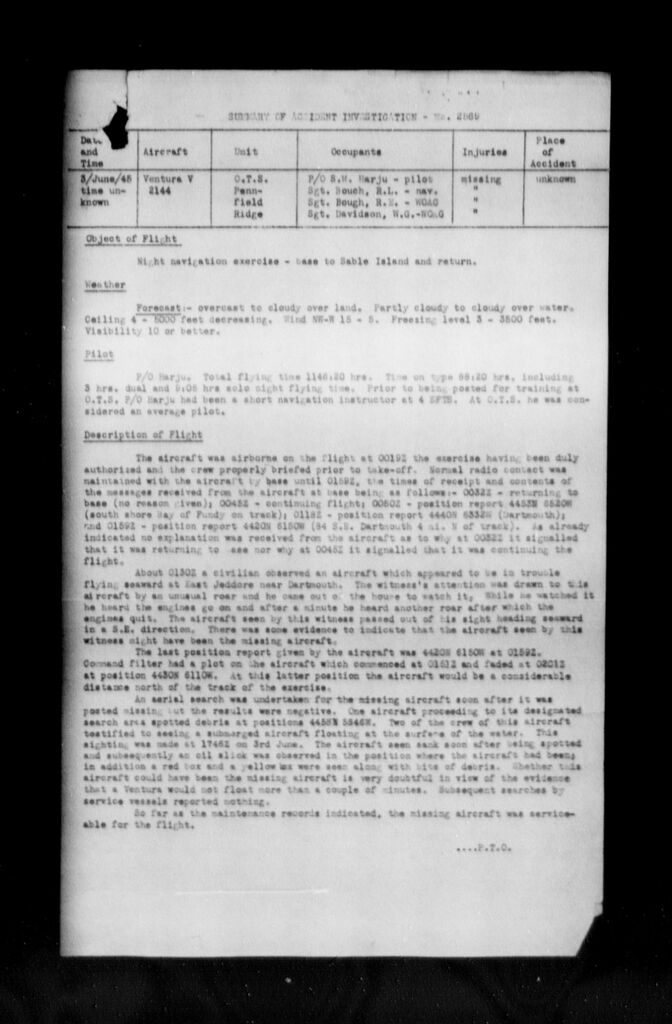



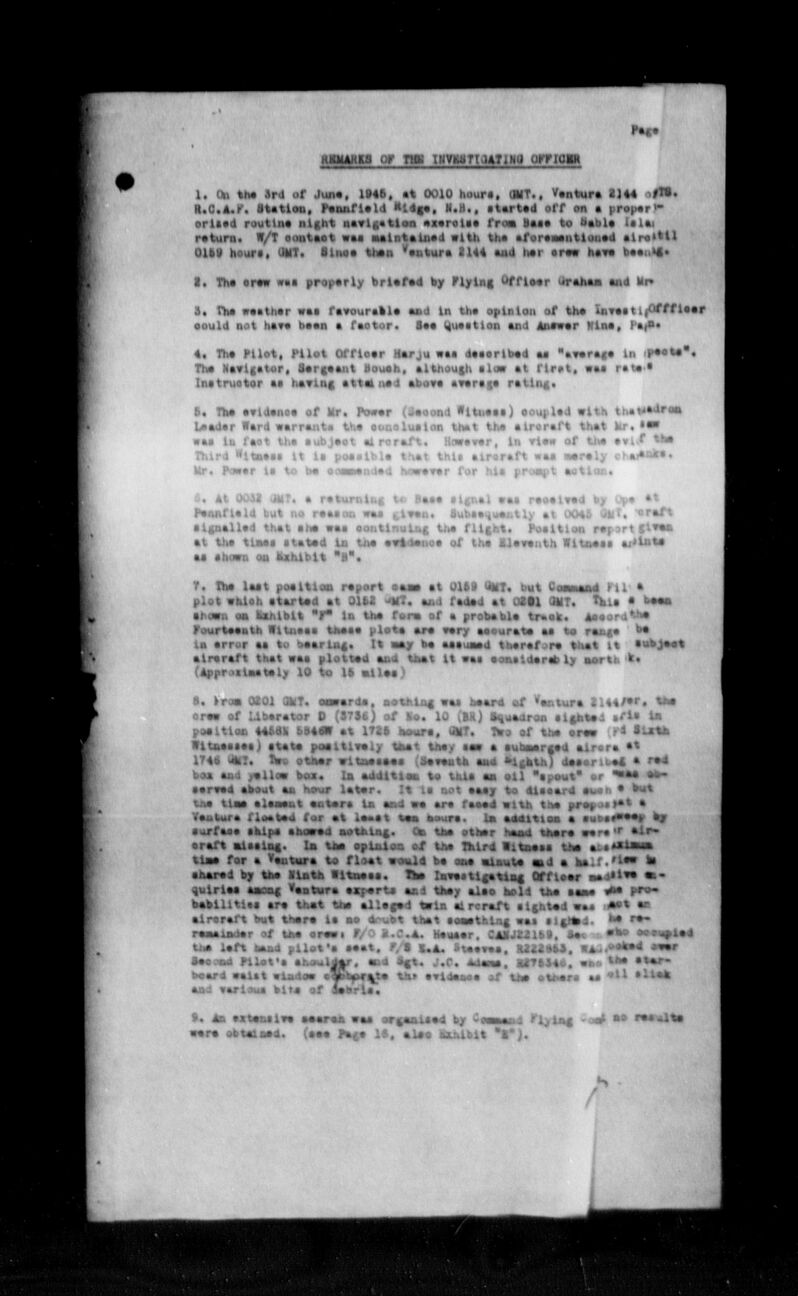
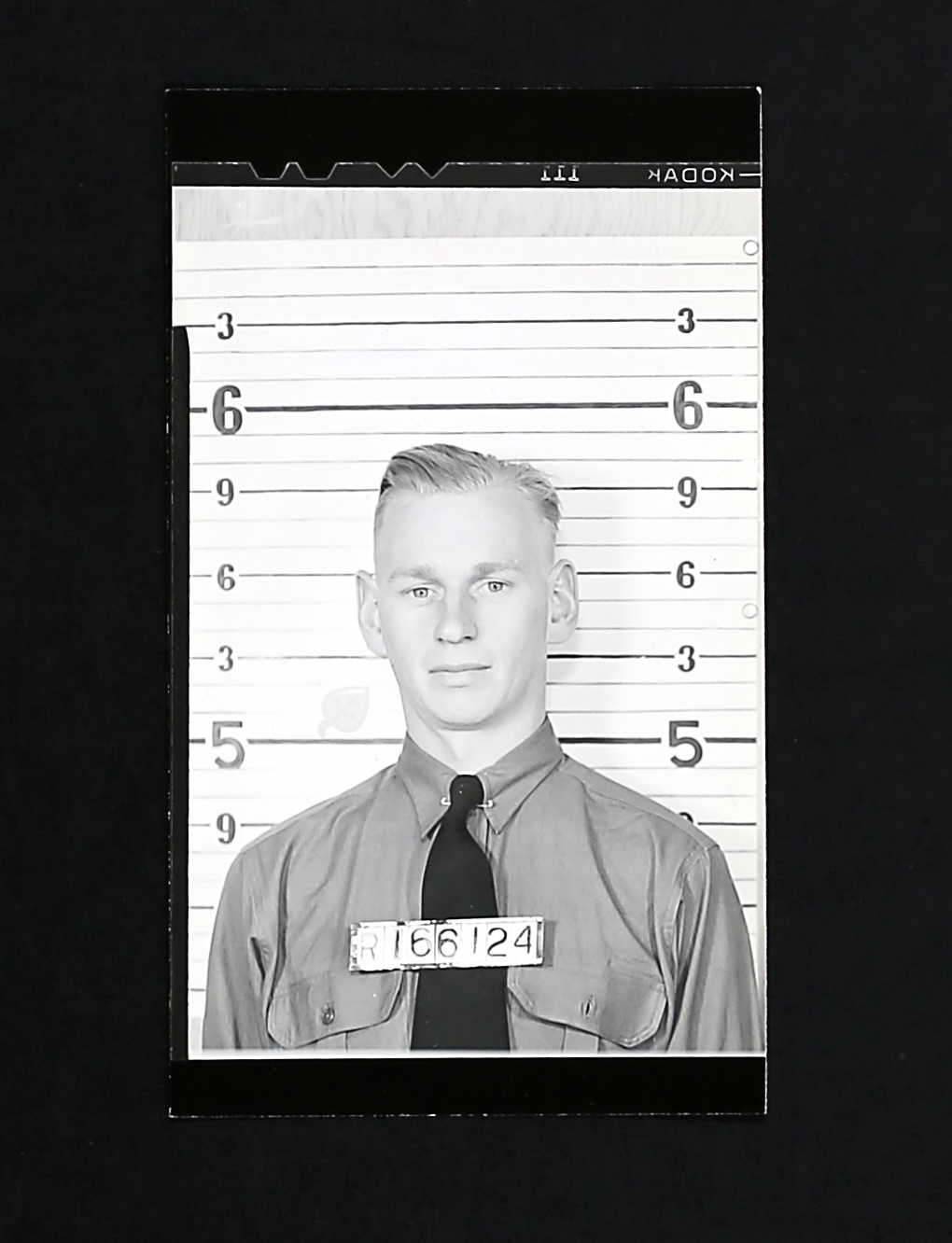
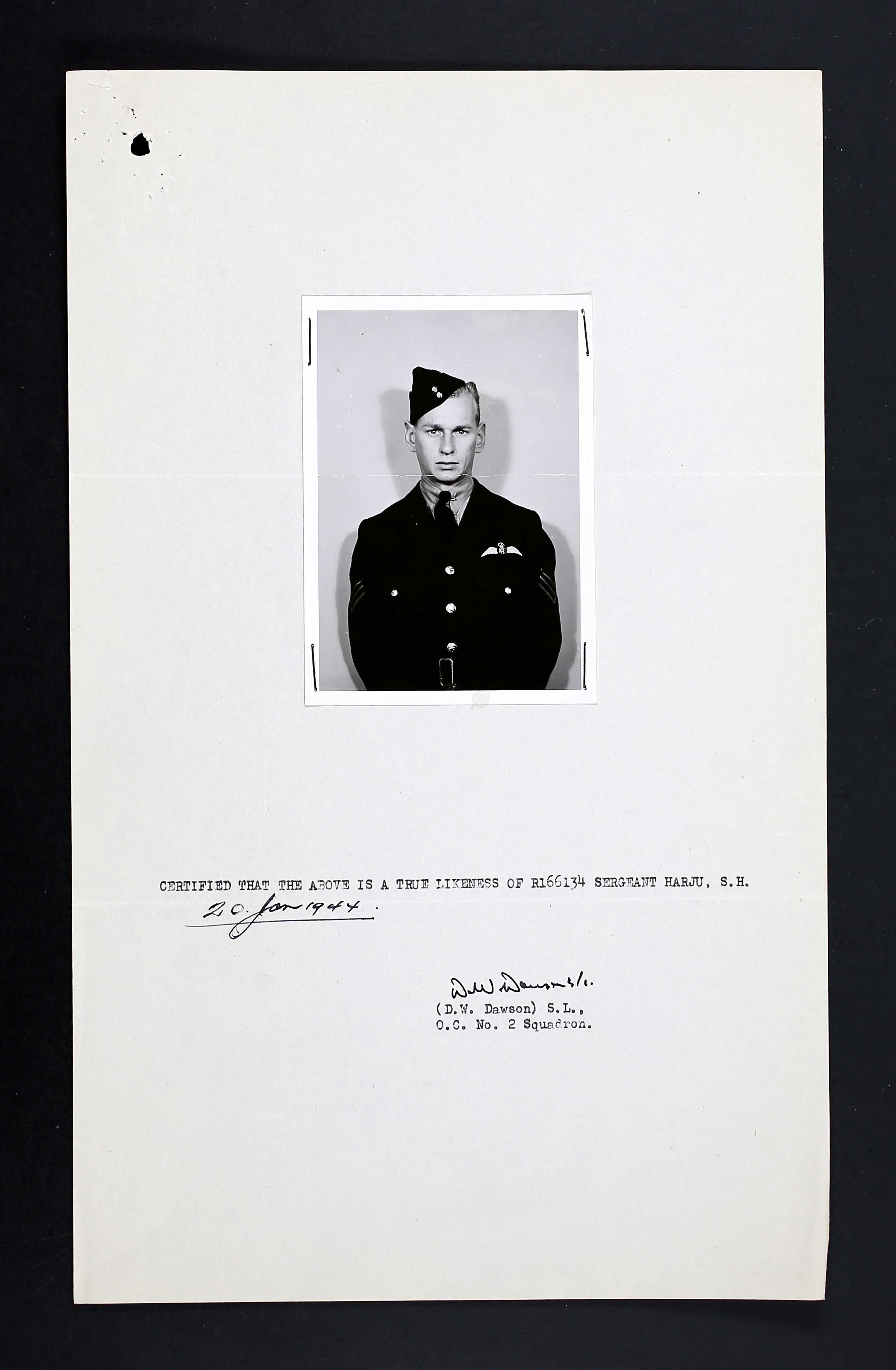
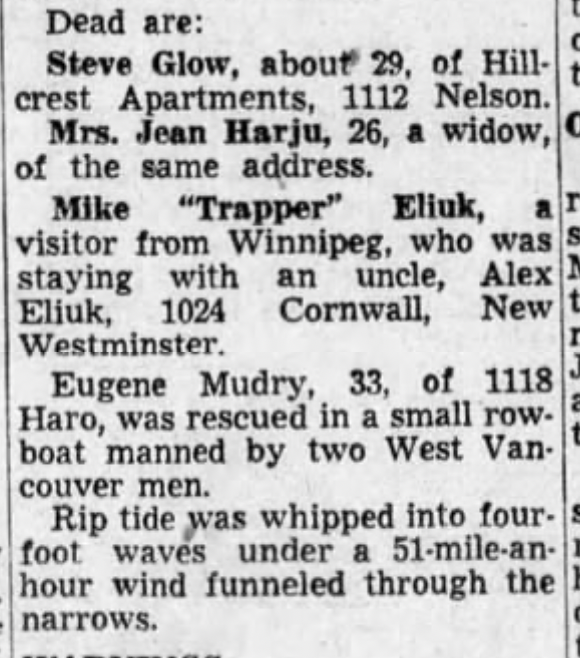
March 8, 1917 - June 3, 1945








Sulo Matt Harju, born in Port Arthur, Ontario, was the son of Ida Sophia (nee Salo) Harju (1886-1948) and John Harju, merchant and postmaster. He had two brothers, Eino and Bill; one sister died, cause unknown. The family was Finnish Lutheran. The family came to Canada in about 1904, taking out naturalization papers in April 1914 at Wetaskiwin, Alberta. Mr. Harju was sworn in as postmaster at Kashabowie, Ontario in 1914.
Sulo married Jean Emily McLellan on November 14, 1940 in Fort William, Ontario. She traveled with Sulo during his time with the RCAF. Upon his death, Jean returned Fort William, borrowing money from her landlady.
Sulo worked as a store clerk in Beardmore, Ontario and assistant postmaster, prior to enlistment with the RCAF, as well as worked as an airplane fitter at Canadian Car and Foundry in 1941 for two months. He also worked in bush camps as a clerk for one year. He had been with the 2nd Bttn the Lake Superior Regiment, NPAM, as of November 22, 1940. Sulo was the treasurer of the Finnish Lutheran Young People’s Society. “Has superior learning ability. Married. Active in sports and social groups. Expects call from RCAF.”
Sulo liked baseball, hockey, fishing and rugby. He smoked 20 cigarettes a day and drank two quarts of beer a week.
When he signed up with the RCAF, he enlisted in Winnipeg, Manitoba where he was working at Winnipeg Cartage Company as a clerk. After the war, he hoped to return to civil service in the post office. He had one brother awaiting a call to join the Canadian Navy.
He stood 5’8”, weighed 154 pounds, had blue eyes and blonde hair with a fresh complexion.
Sulo started his journey through the BCATP at No. 6 Recruiting Centre, Winnipeg, Manitoba on April 30, 1942. He was then sent to No. 3 Manning Depot, Edmonton, Alberta.
He was at No. 7 SFTS until he arrived at No. 4 ITS, Edmonton September 13, 1942. “Fair type. Quiet. Hard worker and displays some initiative. Married.”
From there, he was at No. 23 EFTS, Davidson, Saskatchewan December 1942. “Natural flying ability. Steady type and with no particular faults. A very satisfactory GIS pupil, quiet and conscientious. This man did not show up in tests as he should have done, possibly due to over anxiety, which he will not doubt overcome.” Other comments: “Average pilot material and observer material. A quiet, intelligent candidate in good physical condition, good muscular co-ordination. Motivation only fair, chiefly preference of service. Wants to be a bomber pilot or air bomber.”
Then he was sent to No. 12 SFTS, Brandon, Manitoba February 21, 1943. “This student showed up well in his course and has average flying ability.”
From June 28 to August 20, 1943, Sulo was at Rivers Manitoba, No. 1 CNS. “High average throughout. As instructor: conscientious, adequate, somewhat quiet.” He was 7th out of 24 in his class, rated average as an air navigator, lecturer, intelligence, and application. He earned 72.5%.
Sulo was an instructor at No. 4 SFTS, Saskatoon, Saskatchewan. “This officer has been instructing for over a year. He is very quiet, conscientious, and quite keen. Has given complete co-operation in all Service matters. Would recommend his being retained in the Service and promoted to Temporary F/O.”
Sulo was sent to No. 1 GRS Summerside, PEI and No. 1 RNS, Summerside, February 3, 1945, then to Pennfield Ridge March 17, 1945. “14th out of 22 in class. This officer has average ability and obtained average results on the course. He worked hard and his results would have been much better if he had not make a ‘hash’ of his intermediate DR exam and if he had not been weak in visual signals.” He was recommended for flying boats, land based GR or torpedo bombers. “A steady reliable type who should make a good GR pilot.”
Sulo was in the station hospitals: No. 7 SFTS, August 24 - September 2, 1942, then at No. 4 ITS, September 15 - 17, 1942. This would have been for cellulitis and olecranon bursitis (swelling, redness and pain at the tip of the elbow).
Jean filled out the estates form and indicated that Sulo had $2,217 in life insurance, she the beneficiary.
Ventura 2144 was on night operational training flight was serviceable at time of take-off. There was a decision to turn back which was later reversed. The weather was good, and no distress signal was received at any time. An accident occurred approximately 100 miles east of Halifax.
Crew aboard Ventura GRV 2144: • Sgt Robert Leonard Bouch, R270058, navigator • Sgt Roy Edward Bough, R180547, Air Gunner • F/Sgt William Gordon Davidson, R221311 • F/O Sulo Matt Harju, J24723
A Court of Inquiry was struck. Fourteen witnesses were called. [Full file of accident in reel T12342, starting at image 4285.]
OBJECT OF FLIGHT: Night navigation exercises. Base to Sable Island and back. WEATHER: Forecast: overcast to cloudy over land. Partly cloudy to cloudy over water. Ceiling: 4-5000 feet decreasing. Wing NWW 15-5. Freezing level 3, 3500 feet. Visibility 10 or better. PILOT: F/O Harju total flying time 1146.20 hours. Time on type 88.20 hours, including 3 hours dual and 9:05 hours solo night flying time. Prior to being posted for training at OTS, P/O Harju had been a short navigation instructor at No. 4 SFTS. At OTS, he was considered an average pilot. DESCRIPTION OF FLIGHT: The aircraft was airborne on the flight at 00192, the exercise have been duly just authorized and the crew properly briefed prior to take off. Normal radio contact was maintained with the aircraft by base until 00192, the times of receipt and contents of the messages received from the aircraft at base being as follows: 00322 returning to base bracket no reason given bracket; 00452: continuing flight. [They were then over Dartmouth, then SE of Dartmouth.]
In a memo dated July 6, 1945: “P/O Harju was assessed as an average pilot. His navigator was below average at the beginning of his course, but at the time he went ‘missing,’ he was assessed as above average. The evidence shows that the aircraft was in trouble because at one time during the trip, Ventura 2144 called base and said they were returning to bas. Unfortunately, the reason was not give and a short time later, they called base and said they were resuming the exercise.
“As already indicated, no explanation was received from the aircraft as to why at 00322 it signalled that it was returning to base nor why at 00452 at signal that it was continuing the flight. About 01302, a civilian observed an aircraft which appeared to be in trouble flying seaward at East Jeddore near Dartmouth. The witness’s attention was drawn to this aircraft by an unusual roar and he came out of the house to watch it. While he watched it, he heard the engines go on and after a minute he heard another roar after which engines quit. Seated the aircraft seen by this witness passed out of his sight heading seaward in a southeast direction. There was some evidence to indicate that the aircraft was seen by this witness might have been the missing aircraft. At this latter position the aircraft would be a considerable distance north of the track of the exercise. An aerial search was undertaken for the missing aircraft soon after it was posted missing but the results were negative. One aircraft proceeding to its designated search area spotted debris period two of the crew of this aircraft testified to seeing a submerged aircraft floating at the surface of the water. This sighting was made at 17462 on the 3rd of June. The aircraft seen sank soon after being spotted and subsequently an oil slick was observed in the position where the aircraft had been. In addition, a red box and a yellow box were seen along with bits of debris. Whether this aircraft could have been the missing aircraft is very doubtful in view of the evidence that a Ventura would not float more than a couple of minutes. Subsequent searches by service vessels reported nothing. So far as the maintenance records indicated, the missing aircraft was serviceable for the flight.
“Flying Control said that there were no other aircraft in the vicinity, so it would lead one to believe that the aircraft that the civilian witness saw was the aircraft in question. The investigating officer feels that changing tanks could account for these intermittent periods of running of the engines…The crew of the search aircraft way that they saw an aircraft in that they would see the two engines clearly, the fuselage from the nose about 2/3 back and the mainplane, which did not appear to be damaged. The investigating officer and the engineer officer from Pennfield state that if insurer will not float longer than a minute and a half. The investigating officer, therefore, assumes that it was not the aircraft the crew saw but thinks it was something else cited. I do not concur with the investigating officer’s assumption due to the fact that while a minute and a half is recognized as the normal floating time of a Ventura, there is no reason to disbelieve that this one floated for 10 hours or more. First of all, it appeared to be intact; secondly, it was floating under the water therefore, requiring far less buoyancy. In addition to this, debris which appeared to be emergency kits, 1/2 inflated dinghy, oil slicks in the immediate vicinity of the aircraft, to me show that by some means or other this aircraft has remained floating despite the recognized time of one minute and a half. There is nothing in this evidence to throw any light on this accident, therefore the cause must remain obscure… several aircraft have now reported themselves to be in trouble and crashed after considerable lapse of time period in my opinion, this aircraft had sufficient time to have given base the cause for their decision to return to base. As soon as trouble of any kind is in curd in the aircraft, base is to be notified immediately. As soon as possible, the cause of the trouble is to be determined and the cause plus the symptoms of the trouble are to be sent back to base. The above would serve two purposes. Firstly, it would give the aircraft base a reasonable picture as to the plight the aircraft is in, and secondly with the aforementioned information, a responsible officer may deem it necessary to recall this aircraft due to the fact that he realises that the trouble is more serious than inexperienced crews under training may realize. In addition to this, it might someday give an answer to the engineers which will save many lives in the future, even if the aircraft in trouble is lost.” S/L W. B. Cooper, ASOI
G/C F. S. Wilkins, CI Accidents concurred.
Jean Harju drowned in Vancouver in 1948. She originally was from Stonewall, Manitoba, 40 minutes from Winnipeg. See clipping above. In September 1950, Jean's landlady sought to recoup her money from Jean, hiring a lawyer, unaware of Jean's death. In Harju's Service File there is a letter dated 24-October-1955 from Department of National Defence. A hand-written notation on said letter says: "RETURNED IN MAILS / PENSIONS ADVISE / WIDOW WAS DROWNED / SEND VERIFICATION FORM TO MOTHER". [Thank you to G. Christian Larsen for the note for further investigation.] Also found was an article about Jean admitted to hospital in Vancouver in December 1946 due to poisoning of iodine and Lysol. Jean has no known grave, but is noted on her parents' headstone as LOST AT SEA.